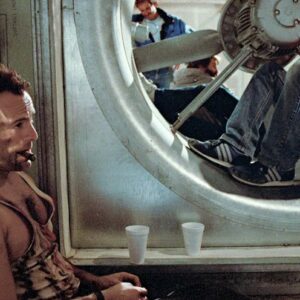Mary J. Blige’s journey from the hard-knock streets of Yonkers to global superstardom is a story of struggle, resilience, and artistic transformation. A voice that defined a generation, Blige’s unique blend of R&B, hip hop, and soul became the soundtrack to the lives of millions. Her tale is not just one of musical success, but of personal triumph over adversity, making her a cultural icon. Of particular significance in her career is the year 2005, when she experienced a breakthrough that would solidify her status as one of the most influential artists of the decade. This was the year Mary J. Blige evolved from a raw talent to an artist fully in command of her craft, emotionally mature, and ready to take on the world.
Early Struggles and Breakthrough Talent
Mary Jane Blige was born on January 11, 1971, in the rough, impoverished neighborhoods of Yonkers, New York. Her early life was marred by hardships that would later fuel the deeply emotional and confessional music she would come to be known for. Raised by a single mother, Blige’s childhood was not easy. Her family struggled with poverty, and she often found herself caught in a cycle of violence, substance abuse, and the harsh realities of living in the projects. Music was an escape—a lifeline—and Blige began singing in church at a young age. She was soon drawn to the soulful sounds of artists like Aretha Franklin, Stevie Wonder, and Gladys Knight, who became her musical influences.
However, Blige’s entry into the music industry was far from glamorous. After being discovered by a record executive who heard her sing along to Anita Baker’s “Caught Up in the Rapture” in a local mall, Blige quickly entered the recording studio. At just 18, she signed with Uptown Records and began working on her debut album, What’s the 411?, which was released in 1992. The album marked the beginning of a new era in R&B, combining soulful melodies with hip-hop beats in a way that had never been done before. The sound was raw and real, mirroring Blige’s own tumultuous life experiences.
What’s the 411? was an instant hit, catapulting Blige to stardom. The album’s success was underscored by its breakout singles like “Real Love” and “You Remind Me,” both of which became anthems of the ’90s R&B scene. Her gritty, honest lyrics spoke to listeners in a way that was both personal and universal, connecting with people who faced similar struggles in their own lives. Blige’s debut solidified her place in the music industry, and it was clear that she was more than just another R&B singer—she was an artist with a unique voice and an undeniable presence.
The 2005 Breakthrough
However, while Blige’s career had gotten off to a strong start, it wasn’t until 2005 that she truly reached the heights of her artistry and commercial success. The release of The Breakthrough that year marked a turning point for Blige, both personally and professionally. By this time, Blige had faced numerous challenges, including struggles with addiction, personal heartbreak, and emotional turmoil. These experiences shaped the album, imbuing it with a sense of maturity and emotional depth that resonated with listeners on a much deeper level than her earlier work.
The Breakthrough was a departure from Blige’s previous albums, showcasing a more refined and polished sound. The album embraced a range of musical influences, from classic soul to contemporary hip-hop, but it was the emotional honesty and vulnerability in her songwriting that truly set it apart. Songs like “Be Without You,” “Enough Cryin’,” and “Not Today” were raw, intimate confessions of pain, heartache, and the resilience needed to overcome them. The album marked a significant evolution for Blige, both in terms of her sound and her growth as an artist.
What made The Breakthrough particularly compelling was Blige’s ability to blend her personal experiences with universal themes of love, loss, and strength. The album showcased a woman who had weathered life’s storms and emerged stronger, more confident, and ready to embrace her true self. She was no longer the vulnerable young woman who had poured her pain into her earlier music; now, she was a force to be reckoned with—powerful, confident, and unapologetic in her authenticity.
Critically, The Breakthrough was met with universal acclaim. The album’s mature sound and emotional depth earned Blige numerous awards and accolades, including eight Grammy nominations and two wins, including Best R&B Vocal Performance for “Be Without You.” This recognition was a testament to her growth as an artist and her ability to connect with audiences on a deep, emotional level.
Collaborations and Recognition
A major factor in Blige’s 2005 success was the powerful collaborations that marked The Breakthrough. Throughout her career, Blige had worked with a variety of artists, but in 2005, her partnerships took on a new significance. Perhaps one of the most notable collaborations was with rapper and producer Kanye West, who contributed to the album’s production. West’s influence is most evident on tracks like “Good Woman Down” and “Take Me As I Am,” where Blige’s soulful voice was perfectly complemented by his hip-hop sensibilities. Their partnership marked a blending of two musical worlds—soul and hip-hop—that resonated with a wide audience and showcased Blige’s ability to transcend genres.
Another standout collaboration was her work with 50 Cent on the track “All I Need,” which further cemented her place in the hip-hop/R&B crossover scene. The success of these collaborations helped Blige gain new audiences while remaining true to her roots in soul and R&B.
Beyond her collaborations, Blige’s accolades in 2005 were a clear indication of her growing stature in the music industry. In addition to her Grammy wins, Blige was also nominated for multiple MTV Video Music Awards, BET Awards, and American Music Awards. Her success was no longer just about record sales or chart positions; it was about the critical and commercial recognition of her artistry.
Personal Transformation
Blige’s personal struggles and triumphs were perhaps the most defining aspects of her career, and they were central to the emotional resonance of The Breakthrough. For years, Blige had battled addiction and tumultuous relationships, including a highly publicized divorce. These personal challenges were not just something she wrote about—they were an intrinsic part of her journey as an artist.
In interviews, Blige has been candid about the emotional and physical toll her struggles had taken on her. Yet, she also spoke of how these experiences shaped her music and gave her the strength to move forward. Blige became a symbol of resilience, proof that it was possible to rise from the ashes of personal destruction and rebuild a life filled with purpose and strength.
Her music became a vehicle for empowerment, especially for women who faced similar struggles. Blige’s willingness to be vulnerable, to share her pain and joy with her listeners, created a deep sense of connection between her and her fans. Through her music, Blige showed that it was possible to be both strong and vulnerable, that pain could be transformed into power, and that healing was a journey that everyone could embark upon.
Cultural Impact
Beyond her musical influence, Mary J. Blige became a cultural icon in the 2000s. Her music was a soundtrack to the lives of countless individuals, but it was her authenticity and ability to connect with people that truly set her apart. Blige’s message of overcoming adversity, embracing one’s flaws, and staying true to oneself resonated deeply with fans, particularly women who saw her as a role model.
In interviews, Blige often spoke about the importance of self-love, resilience, and finding strength in the face of adversity. Her message was one of empowerment—of owning one’s story, no matter how painful or imperfect it may be. She became an inspiration not just through her music, but through her life, which reflected the very struggles and triumphs she sang about.
Blige’s influence extended beyond music, as she became a respected figure in Hollywood, acting in films like Rock of Ages and Mudbound. Her authenticity and ability to express a range of emotions made her a standout in any role she took on, further cementing her place as a multifaceted artist.
Legacy of the 2005 Breakthrough
Looking back, it’s clear that 2005 was a pivotal year for Mary J. Blige. The Breakthrough wasn’t just an album—it was a declaration of her growth as an artist and as a person. The success of the album provided a foundation for the years that followed, as Blige continued to evolve and push the boundaries of her artistry. Her subsequent albums, including Growing Pains (2007) and My Life II… The Journey Continues (Act 1) (2011), continued to explore themes of love, heartache, and empowerment, and Blige’s influence in the music industry remained as strong as ever.
In many ways, 2005 marked the beginning of Blige’s sustained success. It was the year she fully stepped into her power as an artist, embracing both her vulnerabilities and her strengths. As an artist, she had become a trailblazer, redefining what it meant to be an R&B artist in the 21st century. But more than that, Mary J. Blige became a symbol of resilience, a woman who had faced tremendous personal challenges and emerged victorious, her voice ringing louder than ever.
As we reflect on her legacy, it’s clear that Mary J. Blige is more than just a singer or a songwriter—she is an icon, a cultural force whose influence will be felt for generations to come.





